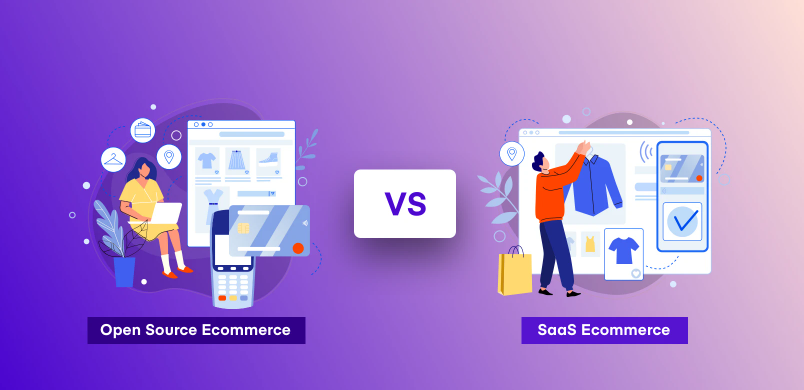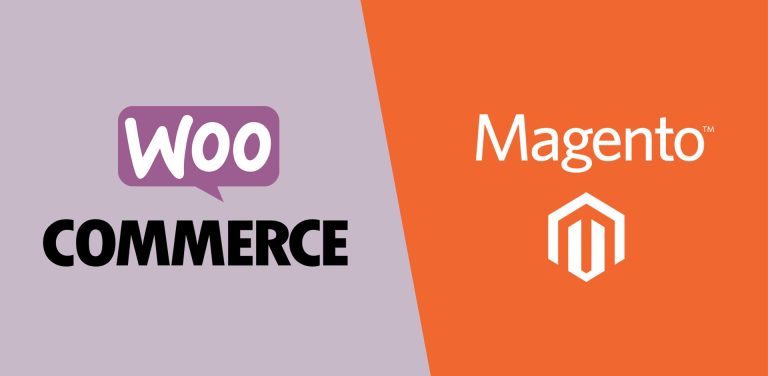Saas vs open source ecommerce: Full Comparison Review – [2023]
Consider SaaS vs open source eCommerce options if you’re looking for an e-commerce platform. Both offer advantages and disadvantages, but which is best for you? In this post, we’ll break down the differences so you can choose the best fit for your business.

What Is SaaS eCommerce?
This particular kind of internet store runs its business using cloud-based software. Most of these e-commerce platforms are subscription-based, meaning companies must pay a monthly or annual charge to utilize them.
A SaaS e-commerce platform offers many benefits, including scalability, flexibility, and lower upfront costs. The eCommerce SaaS platform is also quite adaptable, allowing businesses to customize their store’s design, features, and functionality.
What is open source eCommerce?
Open source e-commerce is a type of online store that uses open source software to power its operations. Anyone may use, modify, and distribute open source software for no cost. This means that anybody may use the open-source e-commerce platform’s code and modify it to suit their needs.
Overall, there are many advantages and benefits of using open source platforms. Open source e-commerce can be the best option for you if you’re seeking a customizable and affordable solution for your online business.
Key Differences Between SaaS vs open source eCommerce
Open source and SaaS e-commerce platforms appear to be almost the same. Both provide you the option to set up an online store and sell goods. The real difference comes when you start learning about the intricacies of customizing and extending your storefront.
Below are some major differences between SaaS vs open source eCommerce software:
Costs
The monthly costs for SaaS platforms are largely determined by the size of your organization (i.e. how many products you have or how many orders are processed per month). In addition to the monthly membership price, you could additionally be assessed a transaction fee. They might differ from one platform to the next. Although SaaS solutions often cost more upfront, they typically cost less overall than open source platforms (at least in the beginning).
Open source e-commerce, however, provides a one-time purchase charge rather than a monthly subscription, making it appear to be more cost-effective than SaaS. Unfortunately, a lot of the maintenance expenses, unstated charges, and revenue losses inherent in open source e-commerce may add up rapidly.
Build Time
It is not difficult to install open source and SaaS platforms. On open source platforms, though, you’ll also need to account for the time it takes to create your shop and prepare it for launch. The length of time it takes you to set up and prepare your store for business is known as the build time. Additionally, the build time for open source software might be extremely long if you are not a computer programmer or web developer. Besides installing the software, you’ll need to set up your hosting and install extensions, as well as choose a theme.
SaaS platforms, however, are set up and ready to use right away. They provide a straightforward user interface and pre-built themes that can be used with little to no scripting experience. You don’t need to worry about it because the providers are in charge of security and storage. You may quickly and easily launch an online store using Shopify, for instance, by pressing a few buttons.
So, if you want to launch and start operating your business as quickly as possible, a SaaS eCommerce platform can be a smart option.
Maintenance

The versatility of Open Source eCommerce means that additional maintenance will be required. Consequently, open source software needs more upkeep than SaaS. SaaS providers will handle the maintenance for you as part of the license, which entails ongoing hosting, monitoring, and software upgrades. Additionally, you will get in touch with them if you need to handle system problems including software bugs, crashes, performance problems, server problems, and more.
Meanwhile, the responsibility for maintaining the open source platform rests with the seller or their development agency, meaning you are responsible for all administrative and infrastructure tasks related to the platform. In an open source setting, it is your responsibility to identify and resolve any issues.
The benefits of open source
There are benefits to open-source software to take into account, such as:
- Flexibility/Complete control: You are in control of the vehicle. You don’t need anyone’s approval to update something, add a new feature, or alter the appearance and feel of your shop.
- Community assistance Since open-source systems are so well-liked, a sizable developer and industry expert community is available to assist you if you run into problems.
- No vendor lock-in: One of the dangers of SaaS platforms is vendor lock-in. If you ever want to leave the platform, it can be very difficult (and often impossible) to take your data with you. With open-source, you own your data and can take it with you if you decide to move on.
Disadvantages of open source
- Complexity: If you’re not a developer, open-source systems might be challenging to utilize. Instead of using a coding platform, you might want to think about a SaaS one.
- Security: Since open-source systems are so well-liked, hackers frequently attack them. This calls for more vigilance about website security.
- Costly expenses: Open source software comes with a variety of high expenditures, including license, hosting, agency fees, and more.
Advantages of SaaS
- Rapid setup: With SaaS, you can get going right away. Nothing needs to be installed, and hosting costs are not an issue.
- Usability: SaaS services are designed to be simple to use.
- Security is the provider’s responsibility because they host the platform. This essentially implies that you may unwind and stop worrying about being PCI DSS compliant or getting hacked.
- Scalability: It’s easy to scale a SaaS platform.
- Customer support: When using a SaaS platform, you have access to customer support. If you ever have a problem, you can get help quickly.
Disadvantages of SaaS
- Customization: can’t customize it to your specific needs.
- Vendor Lockout: It may be extremely difficult (and sometimes impossible) to take your data with you if you decide to quit the platform.
- Upfront costs: if you start from zero, you may not be able to afford the cost of starting a SaaS store.
- Lack of options: When utilizing a SaaS platform, you are only able to use the capabilities offered by the supplier.
Conclusion
Every platform type has advantages and disadvantages, so it’s crucial for organizations to evaluate their requirements and select the one that best meets them. Businesses that want more control over their website should choose an open source-based e-commerce platform, whereas those who desire comfort and simplicity of use should choose a SaaS platform. Whichever platform you decide to use, it’s important to remain current with ecommerce industry trends and developments in order to expand your company.
The top e-commerce development services are offered by ONEXT DIGITAL. We can handle any e-commerce issue, from deployment to migration, with a team of qualified engineers and specialists. Contact us; we can assist you if you need to build your e-commerce business and improve your website.
>>Read also
Top 15+ New Ecommerce Startups You Should Follow (Update 2023)




